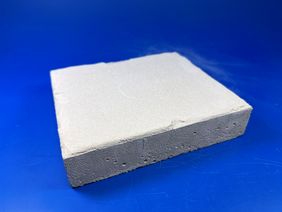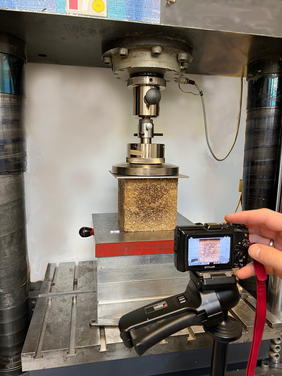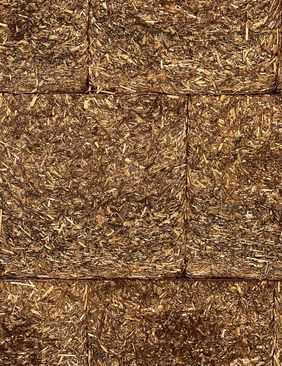
Hannover Messe 2025: The Bauhaus-Universität Weimar Presents Building Materials of the Future
From masonry made out of »Mikrowellenstroh« (microwave straw) and snail slime, to self-healing intelligent concrete – the Bauhaus-Universität Weimar will be represented at this year's industrial trade fair in Hanover with four world premières from the Faculty of Architecture and Urbanism and the Faculty of Civil and Environmental Engineering. The exhibits will be on display from 31 March to 4 April 2025 at the joint »Forschung für die Zukunft« stand, which brings together pioneering research projects from the states of Thuringia and Saxony-Anhalt.
Renewable Raw Materials for the Construction Industry
The construction industry is responsible for nearly 40 percent of all global CO₂ emissions, making a shift towards sustainable materials and construction methods essential. The increasing scarcity and growing prices of raw building materials, as well as the use of non-renewable energies in the production of building materials are among the current challenges that two teams from the Professorship of Construction Design and Structural Design are tackling:
»MikrowellenStroh«
With the »Mikrowellenstroh« (microwave straw), researchers are looking at how to use microwave radiation to make bricks out of straw. The building material is locally available, renewable, and completely recyclable. It also has a small carbon footprint across its entire life cycle. Selective heating of the material without heating the mould should save energy and minimise production risks such as irregular material properties or cracking. The process is meant to ensure uniform heating, especially for large structural elements.
»Masonry Made from Thin-Bed Mortar and Straw Bricks«
This masonry technique enables ecological masonry with thin joints made of straw bricks and thin-bed mortar made of snail slime or other substitutes. It improves the mechanical and physical properties of the building, reduces thermal bridges, and lowers the energy needed for production. The material is free of pollutants, biodegradable, and durable. Furthermore, the reversible solidification makes deconstruction possible. This means shorter processing times, improved load-bearing capabilities, and an appealing and functional design.
Smart Concrete for Tomorrow’s Transportation Infrastructure
Due to increasing loads from things like increased traffic volumes, severe weather events, or extreme temperature fluctuations, the requirements for safe and sustainable transport infrastructure are increasing. The goal is to develop a smart »concrete 2.0« that is adaptable and multifunctional. As part of the »Funktionalisierung smarter Werkstoffe unter Mehrfeldanforderungen für die Verkehrsinfrastruktur« project funded by the Carl-Zeiss-Stiftung with 4.5 million euros, two sub-projects were carried out at the Professorship of Construction Chemistry and Polymer Materials:
»Encapsulating Active Ingredients in Concrete«
Useful active ingredients can be inserted into the concrete in the form of capsules just like medication. The ingredients are safely enclosed in a shell and open only when needed, for instance if there is a change in the pH value of the concrete or if a signal from outside is given (e.g. a specific waveform). The condition of the concrete is constantly monitored through built-in sensors. A signal is sent out if there are critical changes in the material. This causes the capsules to open and release repair materials. As a result, the concrete returns to a non-critical state.
»Photocatalytic Geopolymer Coating«
Fuel combustion in traffic produces nitrogen oxide emissions, which negatively affect the environment and the health of living organisms. To reduce the level of nitrogen oxide in the air, it can be converted into the less harmful nitrate using photocatalysis. This process requires light and a catalyst, such as titanium oxide. Researchers in Weimar have developed a new type of coating made from geopolymers that bind the titanium oxide. To test the photocatalytic effect, mortar panels were coated with the material and the reactivity was tested using a customised NOx measuring stand.
Guests are welcome to visit stand 24 in Hall 2 at the Hannover Messe. Further information under: https://www.hannovermesse.de/aussteller/bauhaus-universitat-weimar/N1573746?editor=visitorView&scene-node=qdlmca3k&exhibitor=bjrh2xy&tdom-loc=y4mou2nr
Kontakt
Bauhaus-Universität Weimar
Claudia Weinreich
Pressesprecherin
Tel.: +49(0)3643/58 11 73
Luise Ziegler
Mitarbeiterin Medienarbeit
Tel.: +49(0)3643/58 11 80
Fax: +49(0)3643/58 11 72
E-Mail: presse[at]uni-weimar.de
Web: www.uni-weimar.de/medienservice




